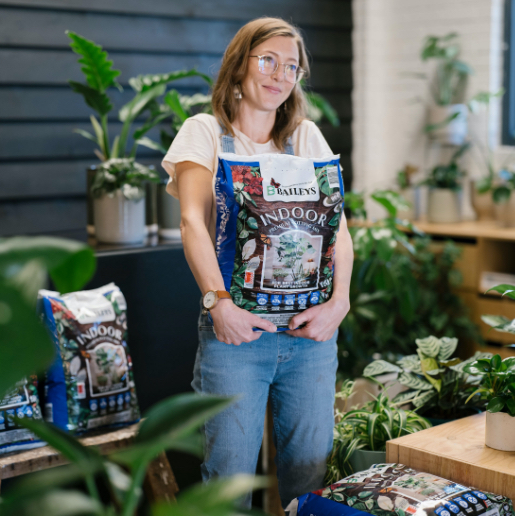
Join our Great Gardens Club!
Sign up to enjoy 15% off your first purchase from Baileys online. Plus, get our monthly WA gardening tips, latest news and promotions straight to your inbox.

Sign up to enjoy 15% off your first purchase from Baileys online. Plus, get our monthly WA gardening tips, latest news and promotions straight to your inbox.
At Baileys, we're committed to continually improving our resource efficiency and reducing our environmental footprint.
Responsible design, use and disposal of our product packaging is key to this commitment, and as such we're signatories of the Australian Packaging Covenant Organisation (APCO).
APCO is a co-regulatory, not-for-profit organisation that partners with government and industry to reduce the harmful impact of packaging on the Australian environment.
As signatories we aim to design packaging and products that are resource efficient, eliminate the use of unnecessary materials, design packaging that is recyclable, reusable or compostable, design packaging that uses recycled or renewable materials and ensuring advice on how to correctly recycle our packaging is easily accessible to our customers.
Baileys are committed to achieving the Australian Federal Governments national target to have:
One of the ways we're embracing sustainability is by using Post-Consumer Recycled (PCR) materials in our packaging. In simpler terms, we?re giving used plastic a second life and reducing our reliance on virgin plastics from fossil fuels. By incorporating 30% PCR into our new Brilliance, 3.1.1. Plus and 4.1.1. bags, we're making substantial progress towards our target of 50% recycled content across all packaging by 2025. We believe that small changes like using PCR in packaging can make a big difference in our collective efforts to combat plastic waste and promote sustainability.
With hundreds of recycling labels out there, getting recycling right can be confusing and even recycling gurus get it wrong. The Australasian Recycling Label (pictured left) removes recycling confusion, and is being added to all Baileys products between 2019-2022.
When we dispose of our waste correctly, we keep contamination out of the recycling stream and recyclable material away from landfill. Things like shape, weight, inks and glues, can impact the recyclability of an item. The Australasian Recycling Label takes all of this into consideration as well as the amount of the population that has access for that item to be recycled via their kerbside recycling collection service.
In November 2022, REDcycle ceased its soft plastics collection program in Australia. Store drop-off is currently not an option for Baileys soft plastic bags as the bins have been removed from all supermarkets. We've started to remove the REDCycle logo and guidance to 'return to store' on our packaging. These updates will take some time to fully roll out and you will continue to see the REDCycle logo on some of our products for a while. Baileys fully supports a prompt resumption of a program to keep soft plastics out of landfill. The AFGC National Plastics Recycling Scheme (NPRS) is developing a much-needed model for kerbside collection so that soft plastics can be sorted and made available for advanced recycling here in Australia. While this is in development, we encourage our customers to check with their local council to see if other recycling options for soft plastics are available in your area. If kerbside recycling is not available in your area, you will need to dispose of the soft plastic packaging in the bin.
The drumMUSTER program collects and recycles eligible, pre-cleaned agricultural and veterinary chemical containers. When you see this symbol on a 20L or 200L drum of Baileys Liquid Fertiliser it indicates that it is drumMuster eligible and can be recycled at one of 800 collection sites across Australia.
Once the containers have been collected, they are recycled into re-usable products such as wheelie bins, road signs, fence posts and bollards.
Find a collection site and more information here.
Baileys 1L, 2L and 5L bottles and containers are made from either high-density polyethylene (HDPE) plastic code 2 or Polypropylene (PP) plastics code 5. These containers are suitable for recycling in your kerbside recycling bins. Please ensure to always rinse out and remove the lid beforehand.
If you have had a large quantity of product delivered, it may have come in a white woven polypropylene bulka bag. Bulka bags can become entangled in the large moving parts of the sorting machinery at recovery facilities and should not be placed in your recycling bin. Instead, store and put out on the kerb at the time of your bulk junk collection. Contact your local council or refer to your waste calendar for bulk verge collection dates.
If you have any further queries about packaging recycling, check out these handy links below.
Don't dump it, recycle it! This is the Planet Ark 'Recycling Near You' website. You can search for local recycling information by Council Area.
Recycle Right is a campaign in WA which encourages and assists residents and businesses to recycle correctly, reduce their rubbish and buy more recycled products.
The REDcycle Program is a recovery initiative for post-consumer soft plastic. Find a drop-off and collection site Australia wide.
The Australian Packaging Covenant (APC) is a sustainable packaging initiative which aims to change the culture of business to design more sustainable packaging. Organisations sign the Covenant to signal their commitment to reduce the environmental impacts of consumer packaging by:
1. Designing packaging that is more resource efficient and more recyclable
2. Increasing the recovery and recycling of used packaging from households and away-from-home sources
3. Taking action to reduce the incidence and impacts of litter.